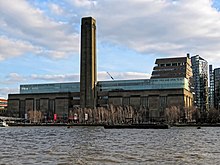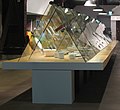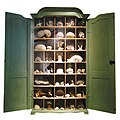The Museums Portal
A museum (/mjuːˈziːəm/ mew-ZEE-əm) is an institution dedicated to displaying and/or preserving culturally or scientifically significant objects. Many museums have exhibitions of these objects on public display, and some have private collections that are used by researchers and specialists. Compared to a library, a museum hosts a much wider range of objects and usually focus around a specific theme such as the arts, science, natural history, local history, and other topics. Public museums that host exhibitions and interactive demonstrations are often considered to be tourist attractions, and many museums attract large numbers of visitors from outside their host country, with the most visited museums in the world regularly attracting millions of visitors annually.
Since the establishment of the earliest known museum in ancient times, museums have been associated with academia and the preservation of rare items. Museums originated as private collections of interesting items, and not until much later did the emphasis on educating the public take root. (Full article...)
Selected museum

Tate Modern is an art gallery in London, housing the United Kingdom's national collection of international modern and contemporary art, defined as from after 1900, and forms part of the Tate group together with Tate Britain, Tate Liverpool and Tate St Ives. It is located in the former Bankside Power Station, in the Bankside area of the London Borough of Southwark.
Tate Modern is one of the largest museums of modern and contemporary art in the world. As with the UK's other national galleries and museums, there is no admission charge for access to the collection displays, which take up the majority of the gallery space, whereas tickets must be purchased for the major temporary exhibitions.
Due to the COVID-19 pandemic the museum was closed for 173 days in 2020, and attendance plunged by 77 per cent to 1,432,991. However, it recovered strongly in 2022, with 3,883,160 visitors, making it the third most visited in Britain and the fourth-most visited art museum in the world.
The nearest railway and London Underground station is Blackfriars, which is 550 yards (0.5 km) from the gallery. (Full article...)
Selected interior image
Selected general article

A collection manager ensures the proper care and preservation of objects within cultural institutions such as museums, libraries, and archives. Collection managers, along with registrars, curators, and conservators, play an important role in collections care. Collection Managers and Registrars are two distinct collection roles that are often combined into one within small to mid-size cultural institutions. Collection Managers can be found in large museums and those with a history and natural history focus whose diverse collections require experienced assessment to properly sort, catalog, and store artifacts. A collection manager may oversee the registrar, archivist, curator, photographer, or other collection professionals, and may assume the responsibilities of these roles in their absence within an organization. (Full article...)
Did you know...
- ... that the Springfield Science Museum is home to the oldest operating projection planetarium in the United States?
- ... that after one of Piet Mondrian's paintings (shown) was discovered to have been hanging upside down for decades, the museum left it as is?
- ... that The Citi Exhibition: Manga at the British Museum was the largest exhibition of manga ever held outside Japan?
- ... that Daniel Sickles's leg is a popular museum display?
- ... that Carl Cotton was the first black taxidermist to work at the Field Museum of Natural History after being hired in 1947?
- ... that a "bat ensnared by a plant" was discovered in the garden of the Palestine Museum of Natural History?
Get involved
For editor resources and to collaborate with other editors on improving Wikipedia's Museums-related articles, see WikiProject Museums.
Selected exterior image
Selected type of museum

A museum ship, also called a memorial ship, is a ship that has been preserved and converted into a museum open to the public for educational or memorial purposes. Some are also used for training and recruitment purposes, mostly for the small number of museum ships that are still operational and thus capable of regular movement.
Several hundred museum ships are kept around the world, with around 175 of them organised in the Historic Naval Ships Association though many are not naval museum ships, from general merchant ships to tugs and lightships. Many, if not most, museum ships are also associated with a maritime museum. (Full article...)
In the news
- 31 May 2024 – Israel–Hamas war protests
- Pro-Palestinian protesters occupy parts of the Brooklyn Museum in New York City, New York, U.S. (Reuters)
Subcategories
Subtopics
Lists
- Museums
- Most visited museums (by region)
- Art museums: most visited, largest
Types
- Art museum
- Agricultural museum
- Archaeology museum
- Architecture museum
- Artillery museum
- Aviation museum
- Biographical museum
- Cabinet of curiosities
- Ceramics museum
- Children's museum
- Community museum
- Computer museum
- Design museum
- Dime museum
- Ecomuseum
- Economuseum
- Ethnographic village
- Farm museum
- Fashion museum
- Folk museum
- Food museum
- Green museum
- Hair museum
- Hall of Memory
- Heritage centre
- Historic house museum
- Human rights museum
- Imaginarium
- Interpretation centre
- Jewish museum
- Lapidarium
- Lighthouse museum
- Living museum
- Local museum
- Maritime museum
- Migration museum
- Mobile museum
- Museum ship
- National history museum
- Natural history museum
- Open-air museum
- Palace museum
- Postal museum
- Prefectural museum
- Print room
- Private museum
- Regimental museum
- Schatzkammer
- Science fiction libraries and museums
- Science museum
- Sex museum
- Sculpture garden
- Technology museum
- Textile museum
- Torture museum
- Toy museum
- Transport museum (list)
- University museum
- Virtual museum
- Wax museum
- Writer's home
Related
Associated Wikimedia
The following Wikimedia Foundation sister projects provide more on this subject:
-
Commons
Free media repository -
Wikibooks
Free textbooks and manuals -
Wikidata
Free knowledge base -
Wikinews
Free-content news -
Wikiquote
Collection of quotations -
Wikisource
Free-content library -
Wikiversity
Free learning tools -
Wiktionary
Dictionary and thesaurus





































































